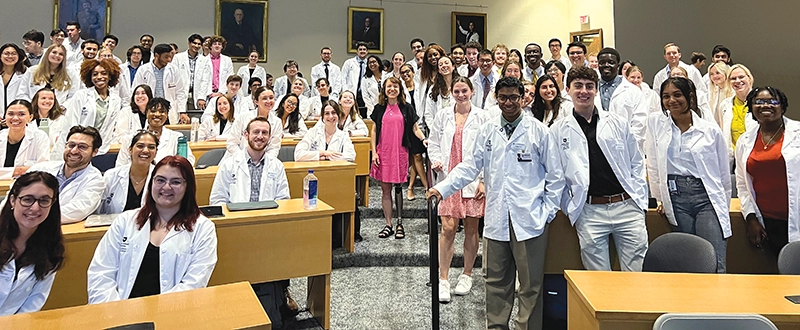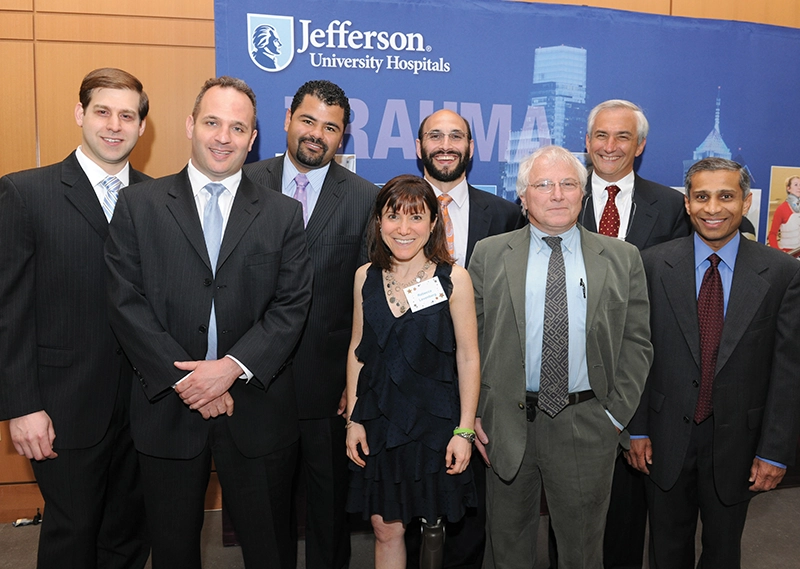Clinicians can read your chart and evaluate your symptoms. But they can’t see the world through your eyes unless you show it to them.
by Rebecca Levenberg
On an August afternoon, I sat around a horseshoe-shaped table with a dozen first-year medical students. Their short white coats were freshly pressed. Their ID tags dangled proudly, minted just days ago. Their faces were open and welcoming, eager to learn what I would teach them.
It was their third day of medical school.

“Before I became a patient,” I began, “this was just a place I rode past on my bike.”
The place was Thomas Jefferson University Hospital, a Level 1 Trauma Center where I had my left leg amputated above the knee after I was hit by a truck while bicycling to work.
I went on to describe the accident: the immensity of the truck, the thud of its axles, the roar of its motor reverberating through my body. I told them how I landed on the cold, hard blacktop, and how frightened and alone I felt, bleeding on the street. I described what came next: the bumpy ambulance ride and the bright, frenetic trauma bay where doctors and nurses flurried around me.
Then I slowed the story down.
I told them about the surgeon who paused, in the heart of all that chaos, to lean in and listen to me. And how, in that one moment of connection, I knew I could trust this team.
“The smallest interactions can make the biggest difference,” I told the students.
I gazed around the table. I tried to look past the white coats and ID tags to see the individuals behind them. It was only Day 3 of their medical education. They had years of training ahead of them. Would my story matter? Would it take hold? Would it even make a ripple in all they had to learn?
After class, the students talked with me. They asked insightful questions. They shared snippets of their own stories: a bike accident, a parent with cancer, a brother with autism. They told me their fears about the future: that they might say the wrong thing to a distressed family, or not know how to help a patient.
Each detail was a window into their lives. I saw their motivations, their struggles, and their drive to make a difference. It’s hard to imagine who our doctors were before they became doctors. This class gave me a glimpse.
The course was called Introduction to Clinical Medicine, but it was the subtitle that caught my attention: Caring for patients begins with understanding the stories they tell.

It touched me that their medical journey started with listening. It took me back to my own Day 3—as a patient.
Although I’d arrived fully conscious, I spent my first two days in the operating room. On Day 3, I lay on a bed in a glass cubicle of the critical care ICU, heavily sedated, breathing through a ventilator, covered with bandages, and swollen with fluid.
I looked nothing like myself. When my sister first glimpsed my body, she felt light-headed and had to step into the hallway. There, a nurse comforted her. “Focus on her hairline and fingernails,” she told my sister, directing her eyes to parts of my body that would still look familiar.
The medical team asked my family to bring in photos of me from before the accident. They tacked them on the wall by my bed. At first, we thought those photos were for our own benefit. But that’s not why the care team requested them.
It was Day 3 for me, but not for my doctors. They were already experts, highly trained trauma surgeons with years of knowledge and skill. In just two days, they had learned my problems inside and out. They knew everything about my injuries.
But they didn’t know me. Yet.
We realized those photos were for my doctors, too. They showed me as a healthy individual, living my full, complex life: walking on the beach, riding my bike, working with students, hiking in the vineyards of France. Those pictures told my story before I could tell it myself. They formed the vision for my recovery, the road map we would navigate together.
If I couldn’t imagine my doctors before they became doctors, how could they imagine me before I was their patient?
I had to teach them.

Putting Limb Loss Into Words
Over time, they learned I was a special education teacher, a rollerblader, the oldest of six siblings, and a writer who loved to travel. They learned that I liked eating bacon and hated drinking hospital-prescribed Boost. They learned that I had flashbacks from the accident, especially at night.
I learned the rhythms of the hospital: shift changes, rounds, and mealtimes. I learned new vocabulary: washout surgery, retention sutures, Xeroform, vancomycin. I learned to pivot on one foot from bed to chair. I learned which nurses were the most organized and which residents could make me laugh during painful bandage changes.
“We’ll get through this,” my doctors told me, even on the most difficult days. I trusted them. We knew each other. We had become a team.
Learning wasn’t as simple as it sounds. When my rehabilitation doctor tried to teach me about wound care, I broke down in tears. In the two months since my amputation, I had not summoned the courage to look at my residual limb.
“You have to love your leg,” she told me. She said it was still part of me, a special part that needed tenderness and love to heal. I cried that day for all my body had been through. It was an exchange filled with more tears than words, but it taught me to take my first steps toward independence and acceptance. Perhaps it taught my doctor something, too: Amputation is both physical and emotional, a challenge that’s unique for each patient.
Thirteen years later, I carry these lessons into every interaction with my healthcare team.
When I meet a new doctor, I introduce myself beyond what I look like physically. “I live independently,” I tell them. “I need to carry grocery bags. Go to work. Take care of myself when I’m sick, even in the middle of the night.” I explain that my ability to walk varies from day to day—not all doctors realize this—so I need to know about accessibility, parking, and whether I’ll have to take off my prosthesis in the exam room.
When I have a specific problem, I give examples of how it affects my life: my morning routine, job responsibilities, energy level, prosthetic fit, or mobility. For those of us with limb difference, even a minor issue can have a major impact on function. Each detail we provide gives the doctor a window into our world—and a chance to view the problem from our perspective.
I often write down questions and concerns ahead of time. Medical visits can be overwhelming and emotional. (I still cry at some of them, even after 13 years!) It’s okay to be vulnerable. It’s okay to say we don’t understand or agree with a medical opinion. A doctor can listen and explore the uncertainty with us.
When I learned to walk with a prosthesis, I lived in a rowhouse where I parked my car on the street. I needed my doctor to complete my application for a handicapped parking space. He had to choose YES or NO in response to this question: Is the applicant able to walk one half city block without assistance or help from another person? He checked YES. Of course I could walk. I had walked into his office, hadn’t I?
My application was rejected.
I made another appointment and returned to clarify my needs. I explained that wearing a prosthetic leg is a form of assistance. Furthermore, I couldn’t always wear my prosthesis, in which case I’d use another form of assistance—crutches, a walker, or a wheelchair. After our conversation, he changed his response. I got the parking space.
The challenges of living with limb loss are easily overlooked, even by medical professionals. When we’re at our most functional, there’s an illusion of ability. We may walk with a natural gait, climb stairs, and navigate crooked sidewalks. We learn new ways to dress ourselves, work in the kitchen, and carry our own luggage. At a doctor’s office, I can walk into the waiting room and take a seat. I can hoist myself onto the exam table without complaint. To the untrained eye, I could be a nondisabled person with an extra-cool leg.
But that functionality changes from day to day. If I’m uncomfortable in my prosthesis, I cancel dates with friends. I leave dirty dishes in the sink to preserve precious leg time. I stay indoors when it snows. Some nights, my residual limb wakes me with shocks of nerve pain.
Being an amputee is not only a balancing act, but a struggle to put into words. It’s hard for an outsider to imagine, so we need to explain our perspective and experience.
Last summer, I injured my right foot—my sound side. This routine situation was a puzzle for the podiatrist. For a typical patient, she would recommend a knee scooter or a boot, or simply advise them to stay off it. For me, none of these solutions made sense. How would I propel a knee scooter with a prosthetic leg? Would wearing a boot throw me off balance? How could I “stay off” my only foot? I got teary-eyed. I was scared that a manageable problem would cascade into something worse. Fortunately, the doctor listened to my concerns and considered other options. We settled on a compression sock, a rigid orthotic plate for my shoe, and limited walking. When I left, I felt hopeful and heard. We had reached a solution that took my personal needs into account.
Why Are We Here?
Even when a medical issue doesn’t concern our amputation, it’s important that doctors understand and respect our challenges. I once saw a specialist for a digestive issue. After looking me over, he felt it was minor and not urgent. “It’s nothing,” he told me. “Why are you even here?”
I had gotten up at 5 a.m. to be ready for that appointment. I had nearly sweated out of my prosthesis in the 90-degree heat. I had arranged a ride because the parking lot was too far to walk on such a hot day. He didn’t consider the obstacles I had faced to keep that appointment. His words invalidated my concern and effort. I was here because this problem was important—to me!

Situations like this reveal how much our doctors don’t know about living with limb loss—and how much we need to teach them.
Our stories matter. They define who we are, and they deserve to be part of the healthcare conversation.
We might have to explain how our prosthetic socket works or why it irritates our skin. We might have to explain how limb loss impacts other parts of our bodies. We might have to explain why a treatment that works for other patients won’t work the same for us. We might have to provide a window into our lives, so doctors better understand “why we’re here.”
According to The New York Times, approximately 80 percent of US medical schools provide training in “narrative medicine,” a discipline that includes listening to and understanding patient stories. Some have programs, such as “Health Mentors” or “Patients with Disabilities as Teachers,” in which patients share their stories with students or healthcare professionals. Most hospitals have departments dedicated to patient-centered care. Many have patient and family advisory councils, where hospital administrators partner with patients and families for feedback and guidance.
Research confirms what we, as patients, already know. Building trust and empathy with our healthcare providers promotes the teamwork and understanding that support good outcomes. But there’s more. A doctor who truly listens—who makes us feel heard—actually changes our brain’s response to stress. It can reduce our perception of pain and promote our healing. Even better, that exchange works both ways. Doctors who listen to their patients tend to report more job satisfaction and less emotional burnout.
We are more than just patients. Our doctors are more than just doctors. We’re all individuals with full, complex lives. To work together, we need to educate and learn from one other.
It’s been a decade since my first conversation with those medical students. Since then, I’ve shared my story with many other groups in the healthcare community, including doctors, nurses, physical and occupational therapists, and pastoral care teams.
Each time I sweep my eyes across a sea of white coats and ID tags, I try to see the individual people beneath. I imagine my story sprinkling down, word by word, and rippling outward to impact future patients and families.
When I finish, it’s my turn to listen. And those caring, compassionate people—so dedicated to making a difference—ask their questions, share their own stories, and leave their impact on me.
Any interaction can be another Day 3—a chance to listen, share, and understand. When we open a window into our lives, we reveal our ability, our disability, and the extraordinary space between.
That is where learning begins.
Rebecca Levenberg is an educator and writer. She coordinates the amputation support program at Jefferson Moss-Magee Rehabilitation in Philadelphia. Learn more at Levenberg’s blog, my-1000-miles.blogspot.com.
Lesson Planning: Teaching Tips for Amputee Patients
Think about the qualities you value in a physician. Do you need a doctor who listens? Who allows time for questions? Who knows that solutions aren’t one-size-fits-all? If a healthcare provider isn’t meeting your needs, start a conversation. Voice your VALUES so you get the treatment you need.
Open a window to your world. Tell the doctor about your daily life. Do you carry an infant? Work in an auto shop? Coach your daughter’s soccer team? How does your current problem impact these joys and responsibilities? Share DETAILS so your doctor can imagine you as a whole person, not just as a patient.
Bring specific concerns and questions. Write them down ahead of time. “My knee pain stops me from walking the dog. How can I move more comfortably?” “My prosthesis is rubbing on my shoulder. Can you give me something to heal the skin?” Focus on clear and tangible GOALS so your doctor can work with you to make things better.
Reveal your vulnerability. Tell the doctor what you’re feeling. “This is my only foot; I’m afraid of making it worse.” “I need my arms to propel my wheelchair and be independent.” “I’m so sad about what happened to me.” While our feelings evolve over time, living with limb loss is an emotional journey. Show your doctor how you feel so you can explore the UNCERTAINTIES together.
Be the expert that you are. You might be surprised how much your doctor doesn’t know about amputee life. Our bodies and equipment—and the issues that go along with them—are as unique as we are. When it’s relevant, be the expert. Tell your doctor what it’s like to live with limb loss or limb difference. (You’ll be amazed how they listen!) Share your KNOWLEDGE to expand your clinician’s understanding.




